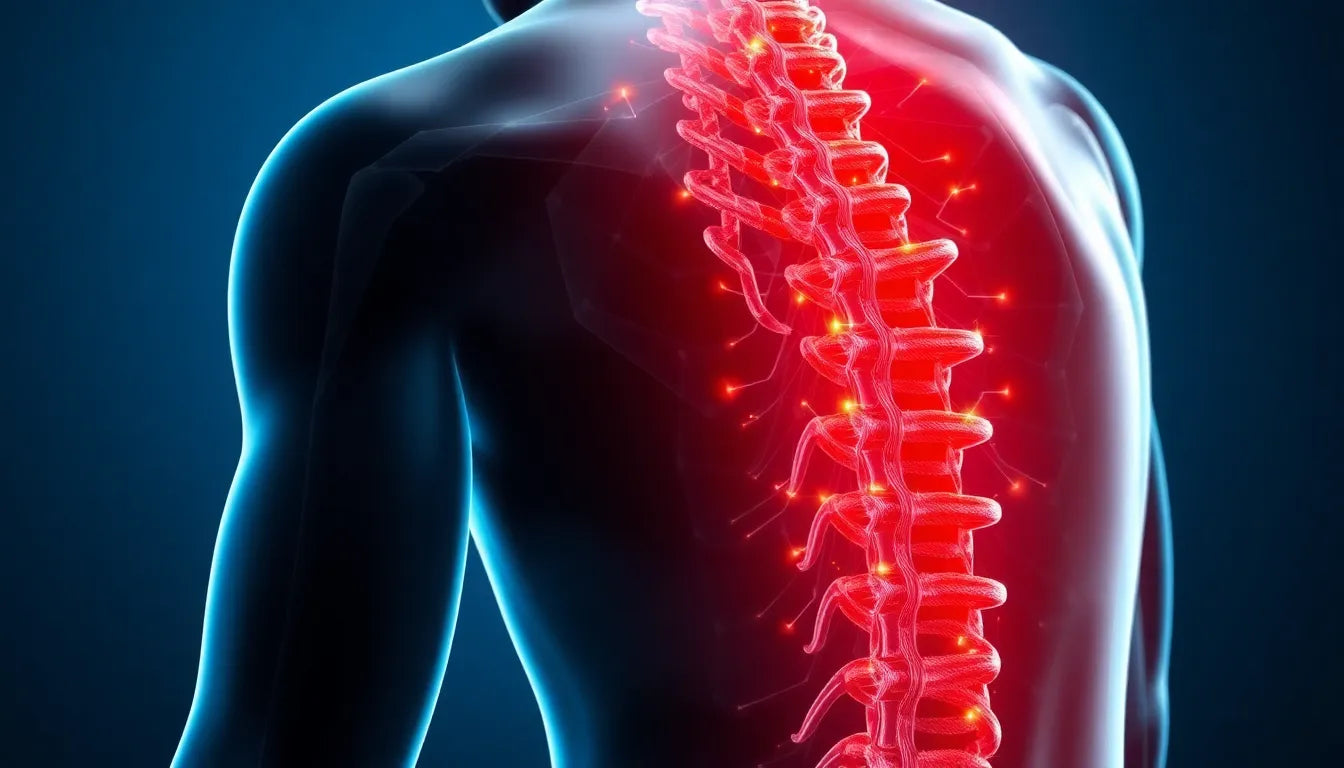The spine, a central pillar of the human body, is an intricate structure composed of bones, nerves, and discs that work together to provide both stability and flexibility. At the heart of this system are the spinal discs, which serve as cushions between the vertebrae. Each disc is made up of two main components: the annulus fibrosus, which is the tough outer layer, and the nucleus pulposus, a gel-like center. These discs play a crucial role in absorbing shock and allowing for smooth movement of the spine, making them vital for everyday activities.
an introduction to bulging and herniated discs
Among the myriad of spinal issues that can arise, bulging and herniated discs are two of the most common. While they might sound similar, they involve distinct differences that are important to understand for accurate diagnosis and effective treatment. A bulging disc occurs when the annulus fibrosus protrudes outward but remains intact, whereas a herniated disc involves a rupture in this outer layer, allowing the nucleus pulposus to escape into the spinal canal. Recognizing these differences is essential, as they can significantly influence the approach to treatment and management.
why knowing the difference matters
Understanding the distinction between bulging and herniated discs is not just a matter of medical terminology; it has real-world implications for those affected. Both conditions can lead to pain, reduced mobility, and other symptoms that can disrupt daily life. However, a herniated disc often results in more severe symptoms due to the potential irritation of nearby nerves. This can lead to intense pain, numbness, or even muscle weakness. By clarifying these differences, this post aims to guide readers toward informed health decisions, promoting better management and treatment outcomes for those dealing with these spinal issues.
definition and anatomy: bulging vs herniated discs
To fully grasp the difference between bulging and herniated discs, it's essential to delve into their anatomical distinctions. A bulging disc occurs when the outer layer, known as the annulus fibrosus, begins to protrude outward. This protrusion happens without any rupture, akin to a hamburger patty that's too large for its bun, causing it to bulge out. Despite its outward pressure, the disc's outer layer remains intact, which typically results in less severe symptoms compared to a herniated disc.
In contrast, a herniated disc involves a breach in the annulus fibrosus, allowing the inner gel-like substance, the nucleus pulposus, to leak into the spinal canal. This rupture can place significant pressure on nearby nerves, often leading to more intense symptoms. The leakage of the nucleus pulposus into the spinal canal is what distinguishes a herniated disc from a bulging disc and is a key factor in the severity of symptoms experienced.
symptoms: understanding the impact
Both bulging and herniated discs can produce a range of symptoms, including back pain, leg pain, tingling, numbness, and a decreased range of motion. However, the intensity and nature of these symptoms can vary significantly between the two conditions. Herniated discs are notorious for causing severe pain due to the direct pressure on spinal nerves, which can lead to symptoms such as intense radiating pain, significant numbness, and even muscle weakness. These symptoms can severely impact daily activities and quality of life.
On the other hand, while a bulging disc can also cause discomfort and pain, it tends to be less severe. The symptoms might be milder because the outer layer remains intact, and the pressure on the nerves is usually not as pronounced as in herniated discs. Understanding these symptom differences is crucial for determining the appropriate treatment and management strategies.
causes and risk factors
Both bulging and herniated discs share several common causes and risk factors. Age-related degeneration is a primary factor, as spinal discs tend to dehydrate and lose flexibility over time, making them more susceptible to both conditions. Other contributing factors include spinal injuries, repetitive stress on the spine, obesity, poor posture, and improper lifting techniques. These factors can accelerate disc degeneration and increase the risk of bulging or herniated discs.
While the causes are similar, the extent of the damage and the specific circumstances leading to a bulging or herniated disc can differ. For instance, a sudden traumatic injury may more likely result in a herniated disc, whereas chronic poor posture might lead to a bulging disc over time. Recognizing these risk factors is essential for prevention and early intervention.
diagnosis: the role of MRI
Accurate diagnosis of bulging and herniated discs is crucial for effective treatment planning, and magnetic resonance imaging (MRI) plays a pivotal role in this process. MRI scans provide detailed images of the spine, allowing healthcare providers to distinguish between the two conditions. By visualizing the integrity of the annulus fibrosus and the presence of any ruptures, MRI can confirm whether a disc is bulging or herniated.
This diagnostic clarity is vital, as the treatment approaches for bulging and herniated discs can differ significantly. MRI not only aids in diagnosis but also helps in assessing the severity of the condition, which is essential for tailoring the most appropriate treatment plan for each individual.
treatment and prevention of bulging and herniated discs
Understanding the treatment options for bulging and herniated discs is crucial for those affected by these conditions. The approach to treatment varies significantly between the two, largely due to the severity of symptoms and the extent of the disc damage.
treatment options for bulging discs
Bulging discs generally require less aggressive treatment compared to herniated discs. Conservative approaches are often effective, focusing on physical therapy and lifestyle modifications. Physical therapy can help strengthen the muscles supporting the spine, improving posture and reducing pressure on the affected disc. Additionally, lifestyle changes such as maintaining a healthy weight, practicing good posture, and using proper lifting techniques can prevent further disc degeneration.
In cases where symptoms are mild and manageable, these conservative methods may suffice. However, if a bulging disc causes significant pain or impacts daily life, medical intervention may be necessary.
treatment options for herniated discs
Herniated discs often require more intensive treatment due to the potential for severe symptoms. Initial treatment typically includes rest, anti-inflammatory medications, and physical therapy to alleviate pain and reduce inflammation. If these measures do not provide relief, more aggressive interventions, such as epidural steroid injections or surgery, may be considered.
Surgical intervention is usually reserved for cases where there is significant nerve compression, leading to muscle weakness or loss of function. The decision to proceed with surgery depends on the severity of symptoms and the impact on the individual's quality of life.
prevention tips
Preventing bulging and herniated discs involves adopting healthy habits that support spinal health. This includes maintaining a healthy weight to reduce stress on the spine, engaging in regular exercise to strengthen core muscles, and practicing good posture both sitting and standing.
It's also important to avoid repetitive spinal stress and use ergonomic aids when necessary. Proper lifting techniques, such as bending at the knees and keeping the load close to the body, can help prevent disc injuries. By incorporating these preventive measures into daily life, individuals can significantly reduce their risk of developing spinal disc issues.
frequently asked questions
what is the main difference between a bulging and herniated disc?
The primary difference lies in the integrity of the disc's outer layer. A bulging disc involves the outer layer protruding without rupture, while a herniated disc involves a rupture, allowing the inner gel-like substance to leak into the spinal canal.
how can I tell if I have a bulging or herniated disc?
Symptoms such as back pain, leg pain, tingling, numbness, and reduced range of motion can indicate either condition. However, herniated discs often cause more severe symptoms. If you experience intense pain or weakness, seek medical advice for an accurate diagnosis.
is surgery always required for a herniated disc?
No, surgery is not always necessary. Many cases are managed with rest, medications, and physical therapy. Surgery is considered if symptoms are severe or if there is significant nerve compression affecting function.
can lifestyle changes help prevent disc issues?
Yes, lifestyle modifications play a crucial role in prevention. Maintaining a healthy weight, practicing good posture, and using proper lifting techniques can help prevent disc degeneration and related issues.
what are the long-term effects of untreated disc conditions?
Untreated disc conditions can lead to chronic pain, nerve damage, and reduced mobility. Over time, this can significantly impact quality of life and may lead to further spinal issues.
Sources
- Mayo Clinic Staff. (2023). "Herniated disk." Mayo Clinic.
- Boden, S. (2023). "What is a Herniated Disc?" Spine-health.
- Neurosurgeons of New Jersey. (2023). "Bulging Disc vs. Herniated Disc."
- DFW Spine Center. (2023). "Bulging Disc vs. Herniated Disc: What’s the Difference?"
- Fayaz, A. (2023). "The Differences Between a Bulging Disc and a Herniated Disc." Fayaz Neurosurgery.


















